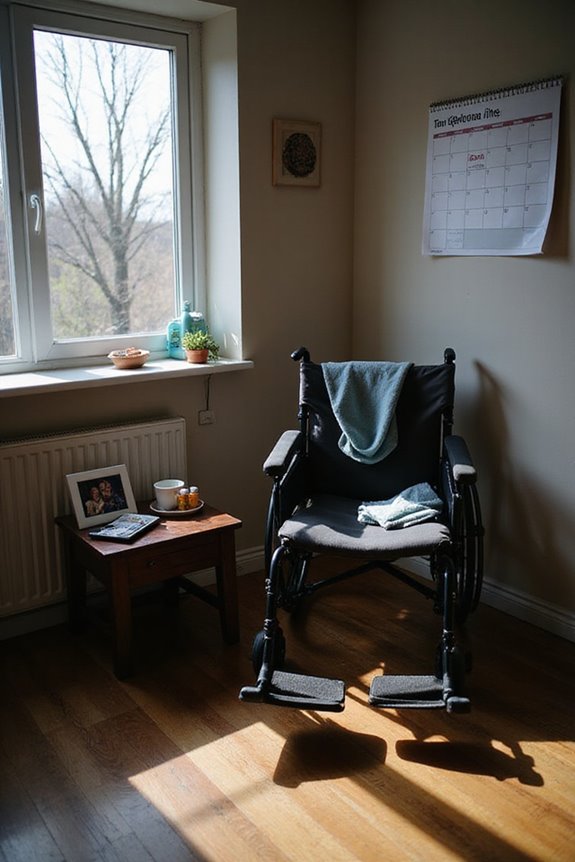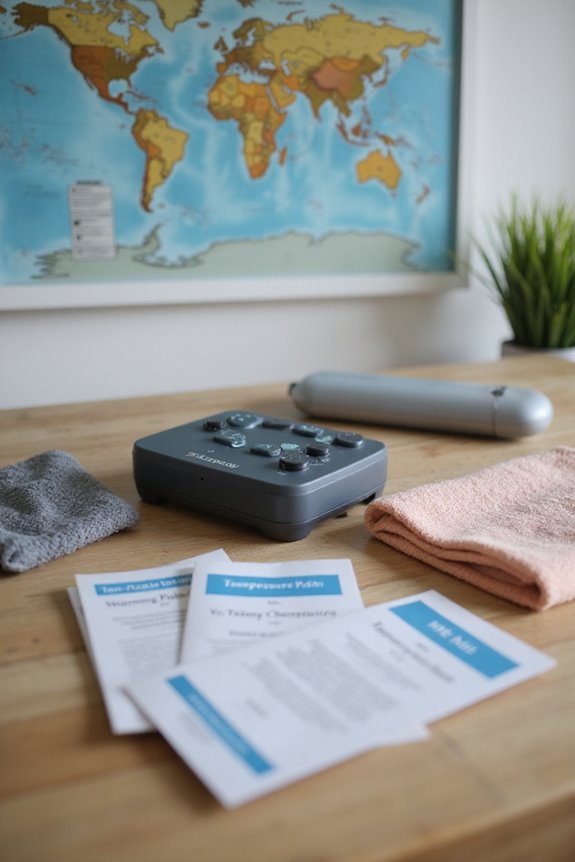Chronic pain conditions substantially affect family dynamics by increasing stress and altering roles within families. Approximately 24.3% of U.S. adults reported chronic pain lasting three months or longer in 2023. Effective communication and robust family support can mitigate emotional strain, while poor family relationships exacerbate pain. Additionally, maladaptive responses, such as overprotectiveness, can hinder coping. Understanding these dynamics is essential for improving family functioning and managing pain effectively. Further examination reveals additional strategies for enhancing family support.
Key Takeaways
- Chronic pain affects family roles, leading to stress and potential burnout among caregivers, altering family dynamics significantly.
- Effective communication within families promotes emotional support, while dysfunctional communication can increase distress and weaken bonds.
- Strong family support can decrease the risk and persistence of chronic pain, whereas poor relationships can exacerbate pain conditions.
- Maladaptive responses, such as overprotection or invalidation, can lead to emotional isolation and increased distress for both pain sufferers and their families.
- Regular family meetings and empathy training can enhance communication and coping strategies, improving overall family dynamics in the face of chronic pain.
Prevalence of Chronic Pain and Its Impact on Families
The prevalence of chronic pain among U.S. adults has reached concerning levels, with 24.3% reporting pain lasting three months or longer in 2023. This increase from 20.4% in 2016 highlights a growing public health issue.
Key statistics include:
- High-impact chronic pain affects approximately 8.5% of U.S. adults, markedly limiting daily activities.
- Demographic disparities exist, with women more likely to experience chronic pain than men.
The implications for families are substantial. Increased caregiving demands often alter family roles, leading to stress and potential burnout. Economic impacts arise from reduced work productivity and the financial burden of caregiving. The unpredictable nature of chronic pain necessitates ongoing adjustments in family dynamics, further complicating caregiving responsibilities.
Family Communication Patterns and Pain Socialization

How do families navigate the complexities of communication when one member experiences chronic pain? Effective family communication styles are vital for addressing pain perception and fostering understanding. Occupational disruptions often trigger conversations about pain, impacting family roles and dynamics.
- Coping Strategies: Families may develop unique approaches to manage pain-related challenges.
- Emotional Support: Positive communication enhances emotional support, bolstering resilience building within the family unit.
- Pain Dialogue: Open discussions about pain facilitate better anxiety management, reducing misconceptions, especially among children.
Dysfunctional communication can lead to increased distress, while supportive dialogue strengthens relational bonds. By recognizing the importance of pain socialization, families can improve their communication patterns, ultimately enhancing overall family functioning and cohesion. Effective pain dialogue is essential for nurturing a healthy family environment.
Emotional Strain and Psychological Effects on Family Members

Emotional strain affects family members greatly when one individual suffers from chronic pain, as the persistent nature of such conditions can induce a range of psychological responses.
- Family members often experience feelings of anger, anxiety, and resentment, stemming from uncertainty about the affected individual’s condition.
- The unpredictability of chronic pain heightens stress levels, contributing to caregiver fatigue and emotional exhaustion.
- Emotional resilience may be challenged as family dynamics shift, leading to role redistribution that can foster resentment.
- Caregivers may struggle to balance support with the encouragement of independence, further complicating emotional well-being.
- Children may feel neglected or anxious due to altered parental behavior, which can negatively impact their psychological health.
Understanding these dynamics is essential to fostering a supportive family environment.
Family Relationship Quality and Pain Outcomes

Family dynamics play a significant role in both the development and management of chronic pain conditions.
- Family Support: Research indicates that robust family support decreases the risk of chronic pain incidence and persistence, particularly among aging African Americans, with a 47-48% reduction in pain persistence over ten years. This support enhances family coping and promotes pain resilience.
- Family Strain: Conversely, family strain, especially in parent-child relationships, raises the likelihood of developing chronic pain by 43%. Chronic exposure to such strain correlates with increased pain severity and interference.
- Interconnectedness: The relationship between family dynamics and pain outcomes is bidirectional. Poor family relationships can exacerbate chronic pain, while effective family coping mechanisms help mitigate its progression.
The Role of Support and Strain in Pain Management

Effective management of chronic pain conditions is greatly influenced by the interplay of support and strain within family dynamics.
- Family strain has been shown to predict increased pain interference, particularly in aging adults, indicating its critical role in pain outcomes.
- Greater family strain correlates with heightened loneliness, which further exacerbates pain perception.
- While family support does not consistently reduce pain interference, it may buffer psychological distress, contributing to family resilience and emotional bonding.
- The complex relationship between support and strain underscores the necessity for thorough assessments in chronic pain management.
- Clinicians are encouraged to incorporate family dynamics into evaluations, recognizing that psychological mediators, such as loneliness, greatly impact pain experiences.
This multifaceted approach is essential for effective pain management.
Closeness in Couples: A Double-Edged Sword
Closeness among couples managing chronic pain can considerably influence relationship dynamics, often creating a complex interplay of support and strain.
- Emotional intimacy may enhance marital satisfaction, particularly on days when partners report feeling close.
- However, satisfying relationships do not always equate to emotional closeness, as some partners may feel content despite emotional distance.
- Increased emotional closeness can lead to heightened distress for the non-pain partner, stemming from caregiving burdens and emotional co-regulation difficulties.
- The dual experience of intimacy and pain can create a ‘double-edged sword’ effect, providing support while amplifying strain.
- Consequently, effective communication interventions are essential to navigate the nuanced partner dynamics inherent in these relationships.
Protective Factors in Family Dynamics
Protective factors in family dynamics play an essential role in managing chronic pain and mitigating its impact on family members. Key elements include:
- Family Cohesion: Supportive family structures, offering warmth and reliability, enhance emotional resilience, reducing the risk of chronic pain more effectively than vigorous physical activity.
- Validation and Control: Validation of pain experiences promotes an internal locus of control, fostering better coping strategies and reducing feelings of helplessness.
- Role Adaptations: Flexibility in family roles maintains stability and prevents resentment, ensuring equitable distribution of caregiving responsibilities.
- Emotional Regulation: Calm family interactions and stress management techniques create a healing environment, lowering inflammation markers associated with chronic pain.
- Social Connection: Trust and positive relationships cultivate resilience, enhancing treatment engagement and adherence within family dynamics.
Maladaptive Responses to Pain Within Families
Maladaptive responses to pain within families can considerably hinder both individual and collective well-being.
- Miscarried Helping: This process involves well-intentioned but harmful supportive behaviors, often leading to worsened family dynamics and increased conflict around pain management.
- Overprotective Responses: While motivated by care, these behaviors can disempower individuals with chronic pain, promoting dependency and increasing distress.
- Invalidating Attitudes: Dismissive responses contribute to emotional isolation, exacerbating psychological distress and undermining trust within the family system.
- Emotional Consequences: Family members may experience guilt, burnout, and resentment, creating a cycle of maladaptive behaviors that reinforce dysfunction.
Addressing these maladaptive responses is essential for improving family functioning and emotional support.
Strategies for Improving Family Support in Chronic Pain Situations
In chronic pain situations, effective family support can greatly enhance both the patient’s experience and the overall family dynamic.
Family Meetings
Regular family meetings facilitate transparent communication, encouraging emotional validation and shared responsibilities.
Empathy Training
Training in empathy and active listening equips family members to respond positively to pain complaints, fostering understanding.
Support Networks
Strengthening natural support networks can mitigate stress and reinforce coping strategies for both patients and caregivers.
Promoting Activity
Encouraging physical and social activities within family settings promotes independence and well-being.
Multidisciplinary Approaches
Integrating families in treatment increases efficacy, as coordinated care reduces individual burdens and enhances resilience.
These strategies collectively contribute to a supportive environment, improving outcomes for chronic pain patients and their families.
Frequently Asked Questions
How Can Chronic Pain Affect Children’s Behavior in the Family?
Children exposed to chronic pain often exhibit behavioral challenges, with studies indicating higher rates of anxiety and depression. Emotional responses may lead to increased hyperactivity and social difficulties, shaping their behavior and relationships within the family context.
What Role Does Financial Strain Play in Families With Chronic Pain?
Financial strain considerably impacts families coping with chronic pain, creating a burdensome cycle. Families often develop coping strategies to manage this financial burden, yet emotional distress and relational challenges frequently arise, complicating their ability to thrive together.
How Can Family Members Best Educate Themselves About Chronic Pain?
In a world where chronic pain looms large, families can empower themselves through thorough chronic pain education. By embracing family support resources, they cultivate understanding and resilience, transforming challenges into a united front against adversity.
Are There Cultural Differences in How Families Respond to Chronic Pain?
Cultural perceptions greatly influence how families respond to chronic pain, affecting levels of familial support. Variations in expression and coping mechanisms across cultures shape the familial dynamics surrounding pain management and the overall caregiving experience.
How Do Lifestyle Changes Impact Family Dynamics When Managing Chronic Pain?
Lifestyle adjustments in managing chronic pain profoundly reshape family dynamics, often leading to increased responsibilities and emotional stress. However, fostering open communication and emotional support can strengthen familial bonds and create a sense of belonging amidst challenges.





